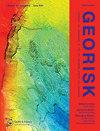卡特里娜和丽塔飓风后迁移和迁移持续时间的决定因素:一个障碍模型方法
IF 4.8
3区 工程技术
Q1 ENGINEERING, GEOLOGICAL
Georisk-Assessment and Management of Risk for Engineered Systems and Geohazards
Pub Date : 2022-08-11
DOI:10.3390/geohazards3030021
引用次数: 0
摘要
2005年,卡特里娜飓风和丽塔飓风在路易斯安那州、阿拉巴马州和密西西比州的部分地区造成了广泛的破坏和流离失所。本研究评估了流离失所的决定因素,并以流离失所为条件,评估了生活在受飓风影响地区的家庭流离失所的持续时间。障碍模型假设不同的过程控制着零结果(即没有流离失所)和积极结果(即流离失所的时间),用于模拟家庭流离失所的可能性及其持续时间,作为社会经济特征、飓风造成的财产和社区损失、社会支持和财政援助的函数。结果表明,流动房屋居住、婚姻状况、受教育程度、子女的存在、财产和邻里损害影响了样本受访者流离失所的可能性和预期时间。财政援助和社会支持也与流离失所及其持续时间有关,但内生性问题使对这些结果的解释复杂化。研究结果强调了导致流离失所家庭回归缓慢的因素的多样性,并强调需要对社会资本在确定与灾害有关的结果方面的作用进行进一步研究。本文章由计算机程序翻译,如有差异,请以英文原文为准。
Determinants of Displacement and Displacement Duration Following Hurricanes Katrina and Rita: A Hurdle Model Approach
In 2005, Hurricanes Katrina and Rita caused widespread destruction and displacement in parts of Louisiana, Alabama, and Mississippi. This research evaluates determinants of displacement and, conditional on being displaced, the duration of displacement for households living in areas affected by these hurricanes. Hurdle Models, which assume that different processes govern zero outcomes (i.e., no displacement) and positive outcomes (i.e., amount of time displaced), are used to model the likelihood of household displacement and its duration as a function of socioeconomic characteristics, hurricane-caused property and neighborhood damage, social support, and financial assistance. Results show that mobile home residence, marital status, educational attainment, the presence of children, and property and neighborhood damage affect the likelihood and expected length of displacement among sample respondents. Financial assistance and social support are also correlated with displacement and its duration, but endogeneity concerns complicate the interpretation of these results. The findings highlight the diversity of factors that slow households’ return following displacement and underscore the need for additional research on the role of social capital in determining hazard-related outcomes.
求助全文
通过发布文献求助,成功后即可免费获取论文全文。
去求助
来源期刊
CiteScore
8.70
自引率
10.40%
发文量
31
期刊介绍:
Georisk covers many diversified but interlinked areas of active research and practice, such as geohazards (earthquakes, landslides, avalanches, rockfalls, tsunamis, etc.), safety of engineered systems (dams, buildings, offshore structures, lifelines, etc.), environmental risk, seismic risk, reliability-based design and code calibration, geostatistics, decision analyses, structural reliability, maintenance and life cycle performance, risk and vulnerability, hazard mapping, loss assessment (economic, social, environmental, etc.), GIS databases, remote sensing, and many other related disciplines. The underlying theme is that uncertainties associated with geomaterials (soils, rocks), geologic processes, and possible subsequent treatments, are usually large and complex and these uncertainties play an indispensable role in the risk assessment and management of engineered and natural systems. Significant theoretical and practical challenges remain on quantifying these uncertainties and developing defensible risk management methodologies that are acceptable to decision makers and stakeholders. Many opportunities to leverage on the rapid advancement in Bayesian analysis, machine learning, artificial intelligence, and other data-driven methods also exist, which can greatly enhance our decision-making abilities. The basic goal of this international peer-reviewed journal is to provide a multi-disciplinary scientific forum for cross fertilization of ideas between interested parties working on various aspects of georisk to advance the state-of-the-art and the state-of-the-practice.

 求助内容:
求助内容: 应助结果提醒方式:
应助结果提醒方式:


